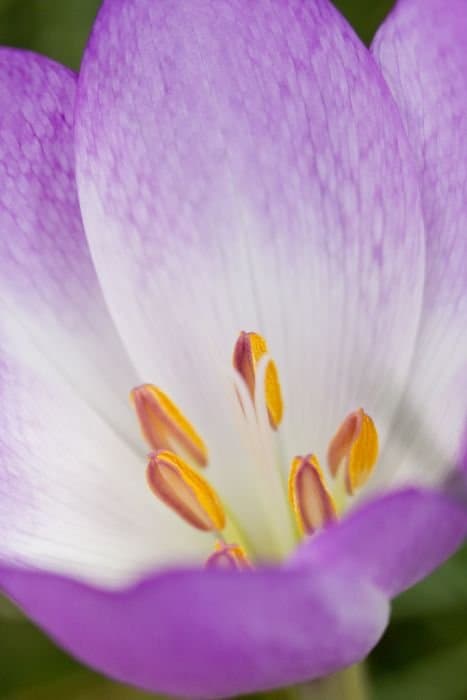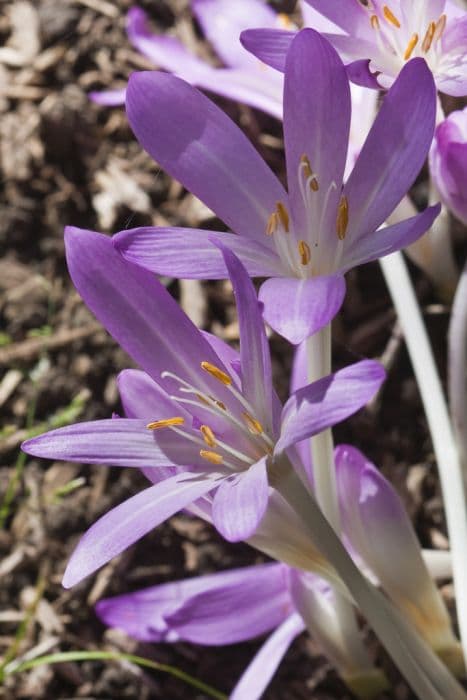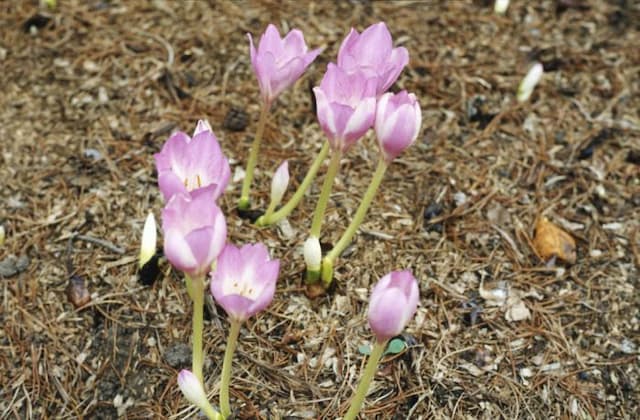Autumn Crocus Colchicum autumnale 'Nancy Lindsay'

ABOUT
Colchicum autumnale 'Nancy Lindsay', commonly known as autumn crocus or meadow saffron, is a perennial bulbous plant that displays striking floral characteristics. This variant of the autumn crocus is well-regarded for its decorative qualities. The flowers emerge directly from the ground without any visible foliage at first, presenting a unique and charming display in the garden. The appearance of the autumn crocus 'Nancy Lindsay' is characterized by its enchanting flowers that have a distinctive cup-like shape. The petals are typically a soft shade of lavender-pink, which can range from pale to slightly more saturated tones, and they have a subtle sheen that catches the light, giving the blooms an almost luminous quality. The flowers' centers are graced with prominent, contrasting yellow stamens, which add an eye-catching focal point to each bloom. Following the blooming period, which usually takes place in fall, the plant will produce leaves. These leaves are glossy and broad, creating a lush, green backdrop that contrasts with the barren soil from which the blooms first appeared. However, the foliage only becomes noticeable after the flowering has finished. Overall, autumn crocus 'Nancy Lindsay' is prized for its ability to add bursts of color to the garden during a time when many other plants have finished blooming. Its distinctive flowers and post-bloom foliage provide an extended period of visual interest.
About this plant
 Names
NamesFamily
Colchicaceae
Synonyms
Autumn Crocus, Meadow Saffron, Naked Lady
Common names
Colchicum autumnale 'Nancy Lindsay'.
 Toxicity
ToxicityTo humans
The autumn crocus contains highly toxic alkaloids, particularly colchicine. If ingested, the plant can cause severe gastrointestinal distress, such as vomiting, diarrhea, and abdominal pain. The toxicity can progress to multisystem organ failure, including kidney, liver, and respiratory failure, potentially leading to death. It is critical to seek immediate medical attention if any part of the autumn crocus is consumed.
To pets
The autumn crocus is highly toxic to pets, including dogs and cats. Ingesting any part of the plant can lead to immediate symptoms like drooling, vomiting, diarrhea, and bloody stools. As the toxicity affects the body, pets may experience severe conditions such as kidney, liver, and heart damage, and bone marrow suppression. Without prompt veterinary treatment, ingestion of autumn crocus can be fatal.
 Characteristics
CharacteristicsLife cycle
Perennials
Foliage type
Deciduous
Color of leaves
Green
Flower color
Pink
Height
6 inches (15 cm)
Spread
6 inches (15 cm)
Plant type
Bulb
Hardiness zones
4
Native area
Europe
Benefits
 General Benefits
General Benefits- Ornamental Value: Colchicum autumnale 'Nancy Lindsay', commonly known as autumn crocus, has a striking floral display with pink to lavender petals that can enhance the visual appeal of gardens and landscapes in the fall.
- Naturalizing: The autumn crocus has the ability to naturalize, which means it can spread and form colonies over time, creating larger and more impressive displays each year without needing to replant.
- Drought Tolerance: Once established, autumn crocus plants are relatively drought-tolerant, making them suitable for gardens with lower water availability.
- Low Maintenance: These plants require minimal care once they are established in the garden, making them a good option for gardeners seeking plants that do not require a lot of maintenance.
- Late Season Bloom: Blooming in late summer to early fall, the autumn crocus provides color and interest in the garden at a time when many other plants are fading or have finished flowering.
- Pest Resistance: Autumn crocus plants are typically not prone to serious pest issues, reducing the need for chemical treatments in the garden.
- Wildlife Attraction: While not a major attractant, the flowers of the autumn crocus can attract pollinators such as bees to the garden, contributing to a healthy ecosystem.
 Medical Properties
Medical Properties- Colchicine content: The plant contains colchicine, an alkaloid that has been historically used to treat acute gout flares and familial Mediterranean fever (FMF).
- Anti-inflammatory effects: The colchicine in the plant has anti-inflammatory properties which make it potentially useful in conditions associated with acute inflammation.
- Antimitotic agent: Colchicine can interfere with the process of cell division (mitosis), which has been utilized in the treatment of some cancers, although not without significant risk and under strict medical supervision.
 Air-purifying Qualities
Air-purifying QualitiesThis plant is not specifically known for air purifying qualities.
 Other Uses
Other Uses- Photography Subject: The Colchicum autumnale 'Nancy Lindsay', or autumn crocus, with its vibrant pink-purple flowers, is often used by photographers as a subject for botanical photography due to its unique autumnal blooming.
- Educational Tool: Botany and horticulture teachers might use the autumn crocus to demonstrate plant biology, particularly bulb propagation and growth cycles that differ from typical spring-flowering plants.
- Natural Dye: Historically, the autumn crocus has been used to produce natural dyes for fabrics, though its toxicity requires careful handling.
- Garden Design: The autumn crocus can provide an unexpected splash of color in fall gardens and is used by landscapers to extend the flowering season in ornamental gardens.
- Flower Arranging: The blooms of the autumn crocus can be used in floral arrangements, especially in late summer and fall when other flowers may be scarce.
- Art Inspiration: The unique look and seasonal appearance of the autumn crocus often inspire artists and illustrators in their work, particularly in creating seasonal-themed art.
- Culinary Decoration: Although the plant is toxic and should not be consumed, its flowers can be used to add ornamental value to plates and platters for culinary presentation, with proper precautions to prevent ingestion.
- Pollinator Attraction: The autumn crocus can attract pollinators such as bees to gardens during a time of year when fewer plants are in bloom, providing an essential resource for these insects.
- Eco-friendly Pesticide Indicator: Due to its sensitivity to certain soil contaminants, the autumn crocus can sometimes be used as an indicator of pesticide overuse or soil health.
- Traditional Celebrations: In some cultures, the autumn crocus might be included in seasonal wreaths or decorations to celebrate autumnal equinoxes or harvest festivals.
Interesting Facts
 Feng Shui
Feng ShuiThe Autumn Crocus is not used in Feng Shui practice.
 Zodiac Sign Compitability
Zodiac Sign CompitabilityThe Autumn Crocus is not used in astrology practice.
 Plant Symbolism
Plant Symbolism- Endurance: Known as the autumn crocus, Colchicum autumnale 'Nancy Lindsay' blooms in fall, defying the typical flowering season, symbolizing endurance and the ability to thrive in adverse conditions.
- Beauty: With its delicate purple-pink flowers, the autumn crocus is often regarded as a symbol of beauty, representing aesthetic appreciation and the elegance of nature.
- Rebirth: As it blooms late in the year when most plants are preparing to go dormant, the autumn crocus symbolizes rebirth and the idea that life can begin anew at any time.
- Hope: The unexpected appearance of its flowers can serve as a symbol of hope, providing a bright spot as the days grow shorter and colder.
- Caution: The autumn crocus contains toxic alkaloids, especially colchicine, making it a symbol of caution and a reminder to respect the potential dangers of nature.
 Water
WaterThe autumn crocus should be watered deeply but infrequently, ensuring the soil is moist without becoming waterlogged. During the growing season, watering once per week with about 1 to 2 gallons of water per plant is adequate, depending on rainfall and soil type. As the plant is dormant in summer, reduce watering significantly. It's important to avoid overwatering, as this can lead to bulb rot. Ensure good drainage to prevent water from pooling around the bulbs.
 Light
LightAutumn crocus thrives best in full sun to partial shade. An ideal spot would be where the plant receives morning sunlight and is protected from the intense afternoon sun. Dappled shade under open-branched trees can also be a suitable location, preventing the leaves from scorching and providing a natural, woodland-like environment.
 Temperature
TemperatureAutumn crocus prefers temperate climates and does well in temperatures between 50°F and 75°F. It is able to withstand winter temperatures down to 20°F, making it suitable for growth in areas that experience cold seasons. Most importantly, the autumn crocus requires a period of colder temperatures to trigger dormancy and subsequent flowering.
 Pruning
PruningAutumn crocus does not require extensive pruning; however, it is beneficial to remove spent flowers and yellowed foliage to maintain a tidy appearance and prevent diseases. The best time for this light pruning is after flowering, in late autumn or early winter, before the plant goes dormant. This minimal upkeep encourages healthier blooms for the following season.
 Cleaning
CleaningAs needed
 Soil
SoilAutumn crocus thrives best in a soil mix that is well-draining and rich in organic matter with a pH range of 6.0 to 7.0. A mix of loamy soil with added compost or peat moss and a handful of coarse sand or perlite to improve drainage will be ideal.
 Repotting
RepottingAutumn crocus bulbs do not need frequent repotting and can be left undisturbed in the soil for several years. They may be repotted or divided every 4-5 years to avoid overcrowding and to maintain vigor.
 Humidity & Misting
Humidity & MistingAutumn crocus prefers moderate humidity levels but is quite adaptable and does not have specific humidity requirements to thrive. Average room humidity is typically suitable for this plant.
 Suitable locations
Suitable locationsIndoor
Place Autumn crocus near bright, indirect light and keep soil moist.
Outdoor
Plant bulbs in partial shade, well-draining soil, and water when dry.
Hardiness zone
4-9 USDA
 Life cycle
Life cycleThe autumn crocus 'Nancy Lindsay' (Colchicum autumnale 'Nancy Lindsay') begins its life cycle with a bulb which lies dormant underground during the summer. With the arrival of cooler autumn temperatures, the bulb produces striking, purple-pink goblet-shaped flowers without foliage, which is unusual for flowering plants. After flowering, the plant withers and enters a period of dormancy throughout the colder winter months. In spring, leaves emerge and photosynthesize to provide energy for the growth of the underground corm, preparing for the next cycle. During late spring and early summer, the foliage dies back and the plant once again goes dormant, storing energy in the corm for the next flowering season. This cyclical pattern repeats annually with the plant's energy reserves being replenished during the leafy stage and expended during flowering and dormancy.
 Propogation
PropogationPropogation time
Autumn to Winter
Propogation: The Colchicum autumnale 'Nancy Lindsay', commonly known as autumn crocus 'Nancy Lindsay', is generally propagated by dividing its corms. The most popular method for propagating the autumn crocus is the division of the corms after the leaves have died back in early summer. Carefully dig up the mature corms, making sure not to damage them, and gently separate the offsets from the parent corm. These new offsets, which are essentially small corms that have developed on the sides of the original, can be planted immediately in well-drained soil at a depth of about 3 to 4 inches (approximately 7.5 to 10 centimeters) and spaced around 6 inches (15 centimeters) apart. Ensure that you plant them in a location that receives dappled sunlight or partial shade. The new corms will then establish themselves over the summer months, preparing to bloom in the following fall.









